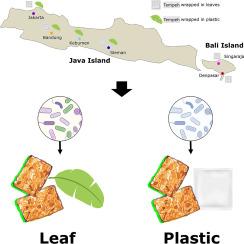豆豉的风土:印度尼西亚各地细菌群落结构的强烈地区特异性特征
IF 4.8
Q1 MICROBIOLOGY
引用次数: 0
摘要
豆豉是印度尼西亚的一种大豆制品,由根瘤菌和相关细菌发酵制成。在此,我们旨在了解印尼各地豆豉微生物群的变异情况,并找出影响因素。我们发现豆豉中的细菌丰度(103 - 109 拷贝 g-1)、丰富度(nASV = 40 - 175 ASVs)和多样性(H' = 0.9 - 3.5)存在很大差异。影响这种差异的主要因素是豆豉的生产地区。有趣的是,从地理位置相近的地区获得的豆豉样本往往具有相似的细菌特征,这表明豆豉具有 "风土 "特征。此外,用香蕉叶包裹的豆豉与用塑料包裹的豆豉相比,肠杆菌的含量更高,但细菌总数和乳酸菌的含量也更高。尽管存在各种差异,豆豉的核心微生物组还是由乳酸菌和肠杆菌组成。这项研究表明,来自当地生产商的传统豆豉中的细菌多样性具有很高的变异性,这凸显了印尼各地强烈的地区性影响。本文章由计算机程序翻译,如有差异,请以英文原文为准。

The terroir of Tempeh: Strong region-specific signatures in the bacterial community structures across Indonesia
Tempeh, a soybean product from Indonesia, is created through fermentation by Rhizopus spp. and associated bacteria. Here, we aim to get an overview of the variability of the tempeh microbiota across Indonesia and disentangle influencing factors. We found high variability in bacterial abundance (103 – 109 copies g-1), richness (nASV = 40 – 175 ASVs), and diversity (H’ = 0.9 – 3.5) in tempeh. The primary factor affecting this variation was the region, where the tempeh was produced. Interestingly, tempeh samples obtained from geographically close areas tended to share similar bacterial profiles, suggesting a "terroir" of tempeh. Additionally, tempeh wrapped in banana leaves had a higher abundance of enterobacteria in comparison to tempeh wrapped in plastic but also tended to have a higher total bacterial and lactobacilli abundance. Despite all variability, the tempeh core microbiome consists Lactobacillales and Enterobacteriales. This study demonstrates a high variability of bacterial diversity in traditional tempeh from local producers highlighting a strong regional influence across Indonesia.
求助全文
通过发布文献求助,成功后即可免费获取论文全文。
去求助
来源期刊

Current Research in Microbial Sciences
Immunology and Microbiology-Immunology and Microbiology (miscellaneous)
CiteScore
7.90
自引率
0.00%
发文量
81
审稿时长
66 days
 求助内容:
求助内容: 应助结果提醒方式:
应助结果提醒方式:


